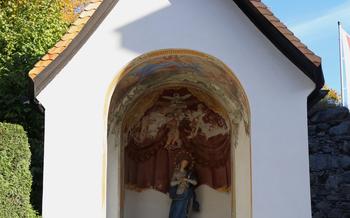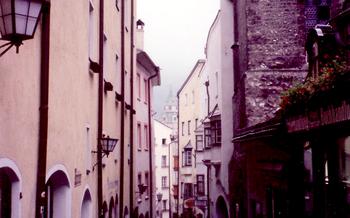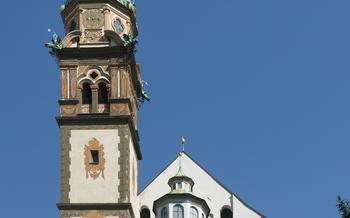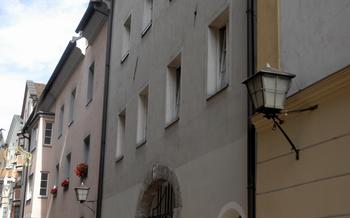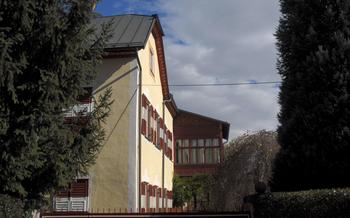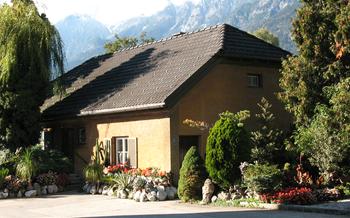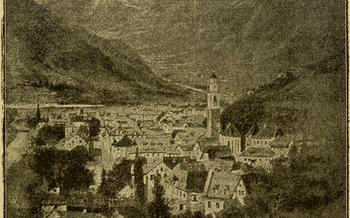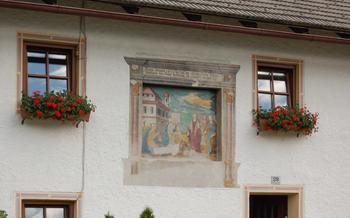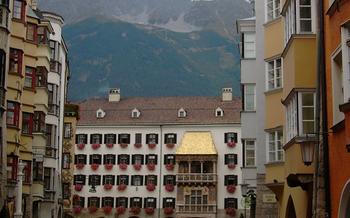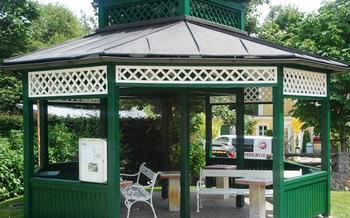
Parish Church of St. Nicholas
- History and Significance
- Impressive Gothic Architecture
- Stunning Stained Glass Windows
- Elaborate Altars and Artwork
- Unique Tyrolean Frescoes
- Impressive Organ
- Tomb of Archduke Ferdinand II
- Captivating Legends and Stories
- Guided Tours and Educational Programs:
- Pilgrimage Site
- Accessibility and Visitor Information:
- Nearby Attractions
- Local Cuisine and Dining Options:
- Accommodation Options
- Insider Tip:
History and Significance
The Parish Church of St. Nicholas, nestled in the heart of Hall in Tirol, holds immense historical and cultural significance. Its construction, dating back to the 14th century, marked the rise of Hall as a prominent trading town. The church showcases a harmonious blend of Gothic and Baroque architectural styles, reflecting the town's rich history and artistic influences. Throughout the centuries, the church has served as a spiritual center for the community, hosting religious services, festivals, and significant life events, deeply entwined with the social fabric of Hall in Tirol.
Impressive Gothic Architecture
The Parish Church of St. Nicholas is a testament to the splendor of Gothic architecture. Its soaring spires, ribbed vaults, and intricate ornamentation create an awe-inspiring sight. The church's exterior is adorned with intricate carvings, gargoyles, and flying buttresses, which not only add to its visual appeal but also serve a functional purpose in supporting the structure. Inside, the ribbed vaults, pointed arches, and elegant columns create a sense of height and spaciousness, drawing the eye upward toward the heavens. The intricate ornamentation, including delicate tracery and floral motifs, further enhances the church's Gothic character.
Stunning Stained Glass Windows
The Parish Church of St. Nicholas is renowned for its exquisite stained glass windows, which bathe the interior in a kaleidoscope of colors. These magnificent creations depict scenes from the Bible, narrating stories of faith, hope, and redemption. The vibrant hues and intricate details of the windows captivate visitors, inviting them to contemplate the profound messages conveyed through these artistic masterpieces.
Each window is a testament to the skill and artistry of the medieval craftsmen who meticulously crafted them. The iconography and symbolism employed in the windows hold deep religious significance, providing a visual representation of the church's teachings and beliefs. The windows serve as a reminder of the power of faith and the enduring presence of the divine in our lives.
The artistry of the stained glass windows extends beyond their religious significance. The techniques employed in their creation, such as the use of grisaille and the intricate leading, showcase the remarkable craftsmanship of the era. These windows stand as testaments to the enduring legacy of medieval art and the enduring power of human creativity.
Elaborate Altars and Artwork
Within the sacred walls of the Parish Church of St. Nicholas, a symphony of artistry unfolds through its ornate altars and religious artworks. The main altar, a masterpiece of craftsmanship, commands attention with its intricately carved wooden structure, adorned with intricate details and glistening gold leaf. Flanking the main altar are two opulent side altars, each dedicated to revered saints, showcasing their lives and miracles through exquisite sculptures and paintings.
The church's interior is further embellished with a collection of captivating sculptures, each narrating a biblical tale or depicting a saintly figure. These sculptures, crafted with precision and imbued with lifelike expressions, contribute to the church's immersive spiritual atmosphere, inviting visitors to contemplate the divine stories they represent.
The harmonious blend of altars and artwork within the Parish Church of St. Nicholas elevates the spiritual experience, providing a visual feast that inspires awe and contemplation. These masterpieces serve as a testament to the artistic prowess and deep faith of the Tyrolean people, transforming the church into a sanctuary of beauty and devotion.
Unique Tyrolean Frescoes
The Parish Church of St. Nicholas is adorned with captivating Tyrolean frescoes, vibrant murals that tell stories from the Bible and showcase the region's rich artistic heritage. Created by local masters, these frescoes depict scenes of religious devotion, biblical narratives, and the lives of saints. The vibrant colors, intricate details, and expressive figures bring the stories to life, creating a visually stunning and spiritually uplifting experience for visitors.
These frescoes are not merely decorative elements; they serve as a powerful tool for religious education and storytelling. Through these artworks, the church communicates its teachings, conveys moral lessons, and inspires devotion among the faithful. The frescoes also reflect the cultural identity of Hall in Tirol, showcasing the artistic traditions and craftsmanship of the region.
One of the most notable frescoes is the depiction of the Last Judgment on the north wall of the church. This awe-inspiring mural portrays the separation of the righteous and the wicked, with Christ seated in judgment, surrounded by angels and saints. The vivid expressions and intricate details of the figures create a sense of drama and urgency, reminding viewers of the consequences of their actions and the importance of living a virtuous life.
The Tyrolean frescoes in the Parish Church of St. Nicholas are a testament to the artistic prowess and spiritual devotion of the region. These masterpieces not only beautify the church's interior but also serve as a powerful reminder of the enduring power of faith and the richness of Tyrolean culture.
Impressive Organ
The Parish Church of St. Nicholas is home to a magnificent organ that adds to its spiritual and musical grandeur. Constructed in the 18th century by the renowned organ builder Franz Reinisch, this impressive instrument boasts over 2,000 pipes, spanning three manuals and 32 stops. The intricate carvings and decorative elements adorning the organ case showcase the craftsmanship and artistry that went into its creation.
The organ's rich and powerful sound fills the church during religious services, concerts, and special events. Its versatility allows it to accompany both traditional hymns and complex classical compositions, enhancing the overall worship experience. The organ is also a testament to the strong musical tradition in Hall in Tirol, where music has played an integral role in the community's cultural identity for centuries.
Tomb of Archduke Ferdinand II
The Parish Church of St. Nicholas holds a significant historical treasure: the tomb of Archduke Ferdinand II, a prominent figure in Tyrolean history and a member of the illustrious Habsburg dynasty. Archduke Ferdinand II, who ruled Tyrol from 1564 until his untimely passing in 1595, was a revered and beloved leader. His tomb, situated within the church, serves as a testament to his legacy and the enduring influence of the Habsburgs in the region.
Crafted from exquisite materials and adorned with intricate carvings, the tomb of Archduke Ferdinand II is a masterpiece of Renaissance artistry. It features a life-sized effigy of the archduke, depicted in his royal regalia, resting peacefully atop a sarcophagus. The tomb is further embellished with intricate bas-reliefs depicting scenes from Ferdinand II's life and reign, as well as allegorical figures symbolizing his virtues and accomplishments.
Beyond its artistic merits, the tomb of Archduke Ferdinand II holds immense historical significance. It represents the deep connection between the Habsburg dynasty and the people of Tyrol, a bond that endured for centuries. The archduke's reign was marked by peace, prosperity, and cultural flourishing, making him a beloved figure among his subjects. His tomb serves as a reminder of this golden era in Tyrolean history.
For visitors interested in exploring the rich history of Hall in Tirol and the Habsburg dynasty, the tomb of Archduke Ferdinand II is a must-see attraction. It offers a glimpse into the life and legacy of a remarkable ruler and provides a tangible connection to the region's past.
Captivating Legends and Stories
Adding a touch of mystery and intrigue to the Parish Church of St. Nicholas are the captivating legends and stories that have been woven around its existence. One popular tale speaks of a miraculous event during its construction when a mysterious stranger appeared, offering his help to the struggling builders. With his superhuman strength, he single-handedly lifted the heavy roof beams into place, ensuring the timely completion of the church.
Another legend tells of a hidden treasure buried beneath the church's foundation. Rumored to have been stashed away by a wealthy benefactor during times of turmoil, the treasure is said to consist of gold coins, precious jewels, and sacred relics. Despite numerous attempts to locate it, the treasure remains elusive, adding to the mystique of the church.
Local folklore also speaks of the church's role as a sanctuary for those seeking refuge from persecution or danger. During turbulent periods in history, the church's crypts and hidden chambers provided shelter and solace to those in need. Stories of secret passages and underground tunnels leading to safety have been passed down through generations, fueling the imagination of visitors and locals alike.
Guided Tours and Educational Programs:
The Parish Church of St. Nicholas offers guided tours that provide visitors with an immersive and informative experience. Led by knowledgeable guides, these tours delve into the history, architecture, and artwork of the church, bringing to life the stories and legends that surround it. Visitors can explore the church's intricate details, learn about its construction and restoration, and gain insights into the religious and cultural significance of its features.
The church also offers educational programs designed to engage visitors of all ages. These programs may include workshops on Tyrolean art and architecture, interactive sessions for children, and seminars on the history and symbolism of the church's stained glass windows. By participating in these programs, visitors can deepen their understanding of the church's rich heritage and gain a greater appreciation for its beauty and significance.
Pilgrimage Site
The Parish Church of St. Nicholas holds a special significance as a pilgrimage site, attracting devout believers from near and far. Over the centuries, pilgrims have flocked to the church to seek spiritual guidance, offer prayers, and pay homage to the sacred relics associated with the church. The church's reputation as a place of miracles and divine intervention has further contributed to its status as a pilgrimage destination.
Pilgrims often embark on a journey to the church to seek blessings, pray for healing, or express gratitude for answered prayers. The church's serene atmosphere and rich history create a profound spiritual experience for those who visit. Special events and celebrations, such as feast days and processions, draw large numbers of pilgrims who come together to celebrate their faith and connect with the divine.
Whether seeking spiritual solace or a deeper connection with their beliefs, pilgrims find comfort and inspiration within the walls of the Parish Church of St. Nicholas. The church's enduring legacy as a pilgrimage site continues to draw visitors who seek a profound and transformative religious experience.
Accessibility and Visitor Information:
The Parish Church of St. Nicholas is easily accessible by foot or public transportation. It is located in the heart of Hall in Tirol, just a short walk from the city's main square and other attractions. The church is wheelchair accessible, and there are facilities for visitors with disabilities. For further inquiries, visitors can contact the parish office or visit the church's website. Operating hours vary depending on the season, so it is advisable to check in advance. Admission to the church is free of charge, allowing visitors to explore its grandeur without any financial barriers.
Nearby Attractions
After exploring the Parish Church of St. Nicholas, visitors can delve deeper into the rich history and culture of Hall in Tirol by exploring nearby attractions.
Hall Mint: Just a short walk from the church, visitors can discover the Hall Mint, a former mint that played a significant role in the region's economy. Here, they can learn about the history of coin production and admire the impressive machinery and exhibits that showcase the minting process.
Hall Castle: Perched on a hill overlooking the town, Hall Castle offers a glimpse into the region's medieval past. Visitors can explore the castle's fortifications, towers, and courtyards, while enjoying panoramic views of the surrounding landscape.
Solarbad Hall: For those seeking relaxation, the Solarbad Hall is an ideal destination. This solar-heated outdoor swimming pool complex features various pools, water slides, and a sauna, providing a refreshing respite during the warmer months.
Museums: Hall in Tirol is home to several museums that offer a diverse range of exhibits. The City Museum Hall in Tirol showcases the town's history and culture, while the Museum St. Nikolaus presents religious art and artifacts from the region.
Nature Trails: The picturesque surroundings of Hall in Tirol invite visitors to explore the region's natural beauty. Numerous hiking trails wind through forests, meadows, and along the banks of the Inn River, offering stunning views and opportunities for outdoor recreation.
These attractions, located within easy reach of the Parish Church of St. Nicholas, provide a comprehensive and enriching experience for visitors seeking to immerse themselves in the history, culture, and natural wonders of Hall in Tirol.
Local Cuisine and Dining Options:
After exploring the captivating Parish Church of St. Nicholas, indulge in the culinary delights of Hall in Tirol. Savor traditional Tyrolean cuisine at charming local restaurants or cafes. The region is renowned for its hearty and flavorful dishes, showcasing the finest local ingredients. Try the iconic Tiroler Gröstl, a savory mix of potatoes, meat, and onions, or the aromatic Käsespätzle, a delectable combination of cheese and egg noodles. For a sweet treat, don't miss the delicious Kiachln, a traditional Austrian pastry filled with jam or fruit. Immerse yourself in the local dining culture and enjoy a memorable culinary experience in Hall in Tirol.
Accommodation Options
For those who wish to immerse themselves in the charm of Hall in Tirol and explore the region at their leisure, a variety of accommodation options are available. From cozy guesthouses and bed and breakfasts to elegant hotels and self-catering apartments, there's something to suit every traveler's preference and budget.
The Hotel Goldener Hirsch, a historic inn dating back to the 16th century, offers a unique blend of traditional Tyrolean hospitality and modern amenities. Located in the heart of the Old Town, it provides easy access to the Parish Church of St. Nicholas and other attractions.
For a more intimate experience, consider staying at a charming guesthouse like Gasthof Sonne. This family-run establishment offers comfortable rooms, a warm ambiance, and a delicious breakfast featuring local specialties.
If you prefer the flexibility of self-catering, several apartments and vacation rentals are available within walking distance of the church. These offer the convenience of a fully equipped kitchen, allowing you to prepare your own meals and enjoy the local produce and culinary delights of the region.
No matter your choice of accommodation, you'll find that Hall in Tirol is a welcoming and hospitable town, where visitors can relax and soak up the unique atmosphere of this historic gem.
Insider Tip:
For a truly awe-inspiring experience, visit the Parish Church of St. Nicholas during the late afternoon when the golden sunlight streams through its magnificent stained glass windows. The play of light and color creates a magical and ethereal atmosphere that transforms the church into a breathtaking spectacle. Be sure to linger for a few moments, allowing the beauty of the stained glass to wash over you, and let the tranquility of the surroundings soothe your soul.
